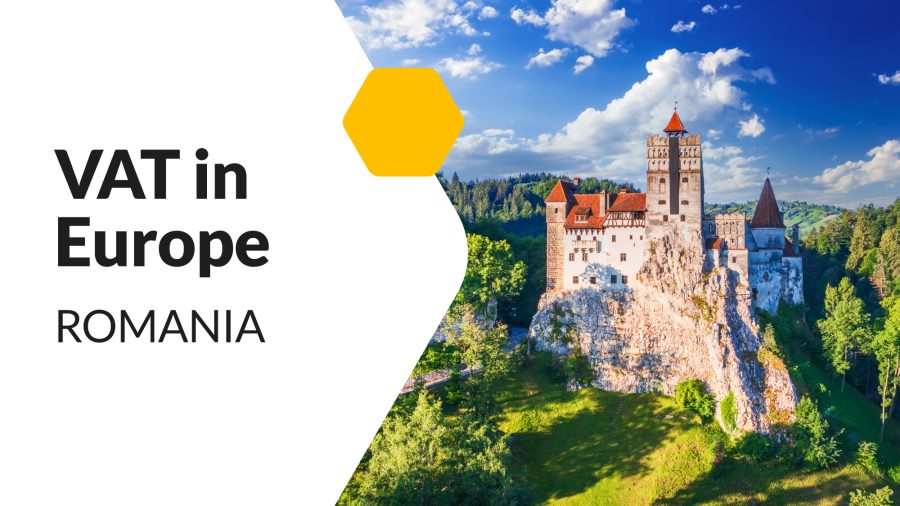Are you shipping goods to customers in Romania? Check if you should register for Romanian VAT and what the VAT rates in Romania are. Read on.
VAT in Romania - table of contents:
VAT was introduced in Romania in 1993, locally referred to as Taxa pe valoarea adaugata. The regulations governing Romanian VAT are outlined in the national Value Added Tax Act of 2003 and in the Romanian VAT code.
When should you register for VAT in Romania?
Non-resident entrepreneurs operating in Romania may be required to register for VAT purposes if they are involved in, among others, the following activities:
- importing goods into the EU as imports through Romania,
- intra-Community sale or purchase of goods from another EU country,
- purchase and sale of goods in Romania,
- storing goods in Romania as consignment stocks for sale to local customers,
- selling goods online to consumers in Romania – if turnover to all foreign consumers exceeds 10,000 euros.
Important!
Entrepreneurs selling goods online to Romanian consumers, once their turnover exceeds 10,000 euros, can register for VAT OSS. This allows them to file one VAT return for all EU member states and pay taxes at the rate of the buyer’s country.
In that case, they don’t need to follow Romanian tax rules except for using the foreign VAT rate. If not registered for VAT OSS, they must follow all rules in Romania, but only for distance sales.
How to register for VAT in Romania?
Businesses must register for VAT within 10 days from the end of the month in which they became liable for registration. EU-based businesses can register directly with the Romanian tax office or use the services of a tax representative.
Businesses from outside the EU can only register through a fiscal representative. Businesses headquartered in the EU, when applying for registration, should provide the following documentation:
- a VAT certificate (notarized copy) if registered elsewhere in the EU,
- the company’s Articles of Association,
- an extract from the national commercial register, and
- documentation proving taxable translations in Romania.
VAT returns in Romania
Every company registered with the Romanian tax office as a non-resident VAT entity must report taxable transactions through periodic reports, known as declarations.
In Romania, the standard period for filing VAT returns is one month. Businesses with an annual turnover of less than €100,000 can file quarterly returns. However, if a business makes intra-Community acquisitions, monthly VAT returns are required.
VAT returns, either monthly or quarterly, must be submitted by the 25th of the month following the end of the accounting period. The tax must also be paid by this date.
Medium and large enterprises, i.e., those with an annual turnover exceeding 7 million RON, must submit Romanian VAT returns electronically.

What should a Romanian invoice include?
Romanian VAT invoices must be issued by the 15th day of the month following the delivery or service provision. Romania, like all EU member states, currently permits the use of electronic invoices under specific conditions.
The Romanian invoice should include, among others, the following elements:
- date of issue,
- sequential number,
- VAT number of the supplier and buyer,
- full name and address of the supplier and customer,
- details of the tax representative in Romania, including VAT identification number – if applicable,
- description of the goods or services provided,
- details regarding the quantity of goods,
- delivery date, if different from the date of issue,
- net value,
- VAT rate,
- VAT amount,
- gross value.
Invoices must be kept for a period of 10 years.
Rates of VAT in Romania
| 19% | standard |
|
| 9% | reduced |
|
| 5% | reduced |
|
| 0% | zero |
|
If you like our content, join our busy bees community on Facebook, Twitter, LinkedIn, Instagram, YouTube, Pinterest, TikTok.
Author: Lucy Adams
She has extensive knowledge in the field of accounting and constantly gains experience working for both small businesses and larger corporations. Her mission is to explain complex financial and accounting issues and teach business owners and those interested in the subject how to manage their finances effectively. She enjoys giving practical advice, discussing current accounting issues, and analyzing legislative changes that may affect business operations. She enjoys a straightforward approach to finance that helps entrepreneurs focus on growing their businesses. She translates complex issues into easy-to-understand language so that anyone can confidently make decisions that impact the success of their business.
VAT in EU:
- VAT in Estonia - a complete guide
- VAT in Denmark - a complete guide
- VAT in Germany - a complete guide
- VAT in the Netherlands - a complete guide
- VAT in the Czech Republic - a complete guide
- VAT in Italy – a complete guide. Rates and registration thresholds
- VAT in Ireland – a complete guide. Rates and registration thresholds
- VAT in Cyprus – a complete guide
- VAT in Spain – a complete guide. Rates and registration thresholds
- VAT in France - a complete guide
- VAT in Lithuania - a complete guide
- VAT in Latvia - a complete guide
- VAT in Slovakia - a complete guide
- VAT in Portugal - a complete guide
- VAT in Romania - a complete guide
- VAT in Belgium - a complete guide
- VAT in Sweden - a complete guide
- VAT in Hungary - a complete guide
- VAT in Greece - a complete guide
- VAT in Finland- a complete guide
- VAT in Austria - a complete guide
- VAT in Malta - a complete guide. Rates and registration thresholds
- VAT in Croatia - a complete guide
- VAT in Slovenia - a complete guide
- VAT in Luxembourg - a complete guide

Set and accomplish your
team goals with Firmbee
21
years
of experience
1.2 M
users trusted
our solutions
+200
team
of experts
+50 M
processed
documents yearly

















